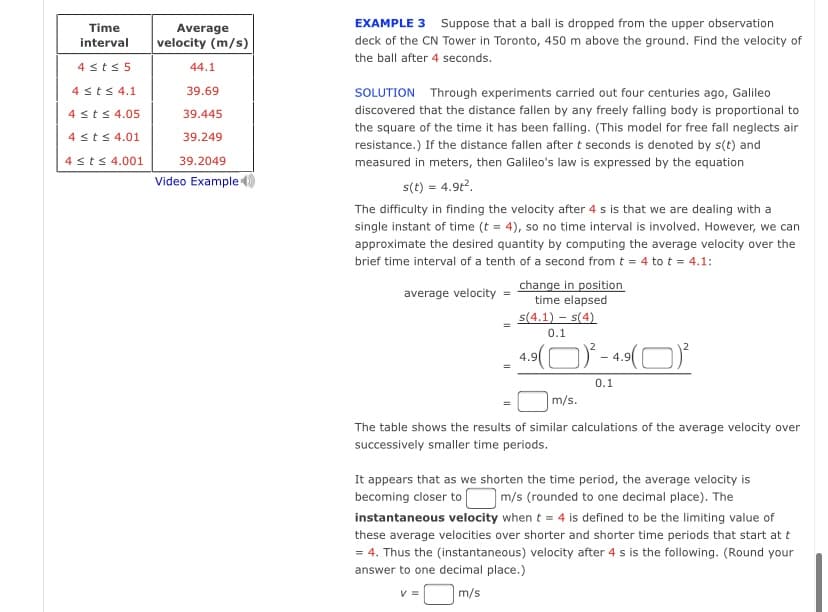EXAMPLE 3 Suppose that a ball is dropped from the upper observation deck of the CN Tower in Toronto, 450 m above the ground. Find the velocity of the ball after 4 seconds. SOLUTION Through experiments carried out four centuries ago, Galileo discovered that the distance fallen by any freely falling body is proportional to the square of the time it has been falling. (This model for free fall neglects air resistance.) If the distance fallen after t seconds is denoted by s(t) and measured in meters, then Galileo's law is expressed by the equation s(t) = 4.9t. The difficulty in finding the velocity after 4 s is that we are dealing with a single instant of time (t = 4), so no time interval is involved. However, we can approximate the desired quantity by computing the average velocity over the brief time interval of a tenth of a second from t = 4 to t = 4.1: change in position time elapsed s(4.1) – s(4) average velocity 0.1 0.1 |m/s. The table shows the results of similar calculations of the average velocity over successively smaller time periods. It appears that as we shorten the time period, the average velocity is becoming closer to instantaneous velocity when t = 4 is defined to be the limiting value of m/s (rounded to one decimal place). The these average velocities over shorter and shorter time periods that start at t = 4. Thus the (instantaneous) velocity after 4 s is the following. (Round your answer to one decimal place.) Om/s
EXAMPLE 3 Suppose that a ball is dropped from the upper observation deck of the CN Tower in Toronto, 450 m above the ground. Find the velocity of the ball after 4 seconds. SOLUTION Through experiments carried out four centuries ago, Galileo discovered that the distance fallen by any freely falling body is proportional to the square of the time it has been falling. (This model for free fall neglects air resistance.) If the distance fallen after t seconds is denoted by s(t) and measured in meters, then Galileo's law is expressed by the equation s(t) = 4.9t. The difficulty in finding the velocity after 4 s is that we are dealing with a single instant of time (t = 4), so no time interval is involved. However, we can approximate the desired quantity by computing the average velocity over the brief time interval of a tenth of a second from t = 4 to t = 4.1: change in position time elapsed s(4.1) – s(4) average velocity 0.1 0.1 |m/s. The table shows the results of similar calculations of the average velocity over successively smaller time periods. It appears that as we shorten the time period, the average velocity is becoming closer to instantaneous velocity when t = 4 is defined to be the limiting value of m/s (rounded to one decimal place). The these average velocities over shorter and shorter time periods that start at t = 4. Thus the (instantaneous) velocity after 4 s is the following. (Round your answer to one decimal place.) Om/s
Algebra & Trigonometry with Analytic Geometry
13th Edition
ISBN:9781133382119
Author:Swokowski
Publisher:Swokowski
Chapter7: Analytic Trigonometry
Section7.3: The Addition And Subtraction Formulas
Problem 74E
Related questions
Question

Transcribed Image Text:Time
EXAMPLE 3 Suppose that a ball is dropped from the upper observation
Average
velocity (m/s)
interval
deck of the CN Tower in Toronto, 450 m above the ground. Find the velocity of
the ball after 4 seconds.
4 sts 5
44.1
4 <t< 4.1
39.69
SOLUTION Through experiments carried out four centuries ago, Galileo
4 <ts 4.05
39.445
discovered that the distance fallen by any freely falling body is proportional to
the square of the time it has been falling. (This model for free fall neglects air
4 sts 4.01
39.249
resistance.) If the distance fallen after t seconds is denoted by s(t) and
4sts 4.001
39.2049
measured in meters, then Galileo's law is expressed by the equation
Video Example )
s(t) = 4.9t.
The difficulty in finding the velocity after 4 s is that we are dealing with a
single instant of time (t = 4), so no time interval is involved. However, we can
approximate the desired quantity by computing the average velocity over the
brief time interval of a tenth of a second from t = 4 to t = 4.1:
change in position
time elapsed
average velocity
s(4.1) – s(4)
0.1
4.9
0.1
m/s.
The table shows the results of similar calculations of the average velocity over
successively smaller time periods.
It appears that as we shorten the time period, the average velocity is
becoming closer toO m/s (rounded to one decimal place). The
instantaneous velocity when t = 4 is defined to be the limiting value of
these average velocities over shorter and shorter time periods that start at t
= 4. Thus the (instantaneous) velocity after 4 s is the following. (Round your
answer to one decimal place.)
V =
m/s
Expert Solution
This question has been solved!
Explore an expertly crafted, step-by-step solution for a thorough understanding of key concepts.
This is a popular solution!
Trending now
This is a popular solution!
Step by step
Solved in 2 steps with 2 images

Recommended textbooks for you

Algebra & Trigonometry with Analytic Geometry
Algebra
ISBN:
9781133382119
Author:
Swokowski
Publisher:
Cengage

Functions and Change: A Modeling Approach to Coll…
Algebra
ISBN:
9781337111348
Author:
Bruce Crauder, Benny Evans, Alan Noell
Publisher:
Cengage Learning

Algebra & Trigonometry with Analytic Geometry
Algebra
ISBN:
9781133382119
Author:
Swokowski
Publisher:
Cengage

Functions and Change: A Modeling Approach to Coll…
Algebra
ISBN:
9781337111348
Author:
Bruce Crauder, Benny Evans, Alan Noell
Publisher:
Cengage Learning